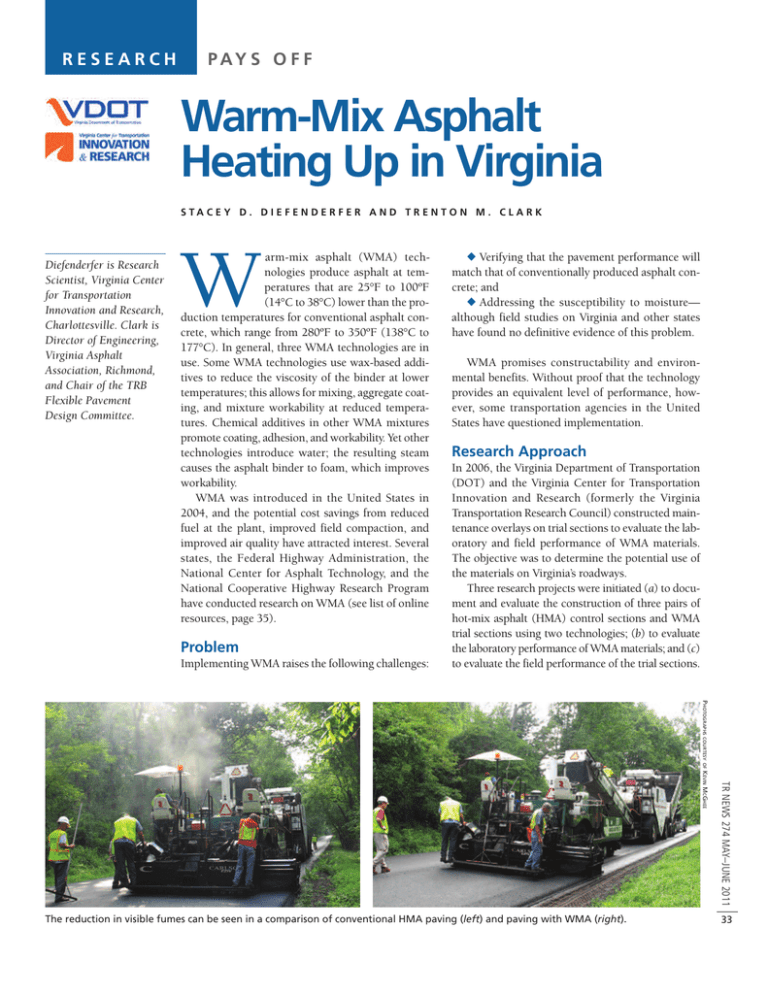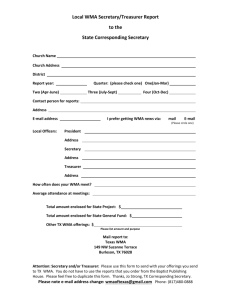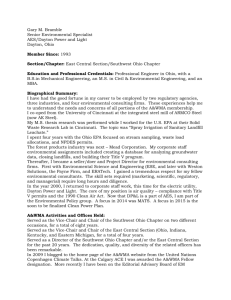W Warm-Mix Asphalt Heating Up in Virginia
advertisement

RESEARCH PAY S O F F Warm-Mix Asphalt Heating Up in Virginia S TA C E Y D . D I E F E N D E R F E R A N D T R E N T O N M . C L A R K Diefenderfer is Research Scientist, Virginia Center for Transportation Innovation and Research, Charlottesville. Clark is Director of Engineering, Virginia Asphalt Association, Richmond, and Chair of the TRB Flexible Pavement Design Committee. W arm-mix asphalt (WMA) technologies produce asphalt at temperatures that are 25°F to 100ºF (14°C to 38°C) lower than the production temperatures for conventional asphalt concrete, which range from 280ºF to 350ºF (138°C to 177°C). In general, three WMA technologies are in use. Some WMA technologies use wax-based additives to reduce the viscosity of the binder at lower temperatures; this allows for mixing, aggregate coating, and mixture workability at reduced temperatures. Chemical additives in other WMA mixtures promote coating, adhesion, and workability. Yet other technologies introduce water; the resulting steam causes the asphalt binder to foam, which improves workability. WMA was introduced in the United States in 2004, and the potential cost savings from reduced fuel at the plant, improved field compaction, and improved air quality have attracted interest. Several states, the Federal Highway Administration, the National Center for Asphalt Technology, and the National Cooperative Highway Research Program have conducted research on WMA (see list of online resources, page 35). Problem Implementing WMA raises the following challenges: u Verifying that the pavement performance will match that of conventionally produced asphalt concrete; and u Addressing the susceptibility to moisture— although field studies on Virginia and other states have found no definitive evidence of this problem. WMA promises constructability and environmental benefits. Without proof that the technology provides an equivalent level of performance, however, some transportation agencies in the United States have questioned implementation. Research Approach In 2006, the Virginia Department of Transportation (DOT) and the Virginia Center for Transportation Innovation and Research (formerly the Virginia Transportation Research Council) constructed maintenance overlays on trial sections to evaluate the laboratory and field performance of WMA materials. The objective was to determine the potential use of the materials on Virginia’s roadways. Three research projects were initiated (a) to document and evaluate the construction of three pairs of hot-mix asphalt (HMA) control sections and WMA trial sections using two technologies; (b) to evaluate the laboratory performance of WMA materials; and (c) to evaluate the field performance of the trial sections. PHOTOGRAPHS COURTESY OF TR NEWS 274 MAY–JUNE 2011 KEVIN MCGHEE The reduction in visible fumes can be seen in a comparison of conventional HMA paving (left) and paving with WMA (right). 33 TABLE 1 Core Air Voids Average Air Voids, % (standard deviation) Trial A Trial B Trial C Age HMA WMA HMA WMA HMA WMA Initial 7.7 (1.1) 6.7 (1.8) 9.2 (1.3) 8.1 (2.5) 7.6 (1.6) 9.4 (3.5) 3-month 6.0 (0.9) 6.8 (1.9) 8.0 (2.5) 8.3 (2.7) 9.6 (1.8) 9.2 (3.0) 6-month 6.2 (0.7) 7.8 (1.4) 8.4 (2.1) 7.9 (1.5) 7.1 (2.4) 7.4 (2.1) 1-year 5.5 (0.7) 7.4 (1.9) 6.6 (0.9) 7.3 (0.8) 7.0 (2.7) 7.6 (1.9) 2-year 7.1 (1.2) 7.5 (1.1) 9.6 (1.0) 7.4 (1.5) 6.3 (0.8) 8.6 (2.7) Construction and Field Performance Construction of the HMA and WMA sections for each trial followed standard HMA paving practices; the only exception was the WMA’s lower production temperature. In Trial A and Trial B, the WMA used an organic wax additive; in Trial C, the WMA used an emulsion technology. Density was measured with a nuclear gauge and cores during construction. Field cores and loose material from the plant were collected for laboratory testing. Coring and visual inspections were performed during construction and at intervals of 3 months, 6 months, 1 year, and 2 years. Cores were tested to determine the air void contents before the extraction and recovery of the asphalt binder for performance grading. Table 1 (above) shows the differences in the air void contents of the HMA and WMA in each trial; these were not statistically significant at a level of ␣ = .05. Nuclear density measurements generally supported these observations for the WMA in Trials A and B. The difference in the nuclear density measurements of the compacted WMA and HMA sections from Trial C was significant at ␣ = .05. Performance grading of the recovered binders indicated that the WMA from Trials A and B aged during the first 2 years in service at a slightly reduced rate from that of the HMA, indicated by a reduced rate of stiffening. No difference was measured in the performance grade between the HMA and WMA in Trial C. Laboratory Evaluation All mixtures for the field trials underwent laboratory testing. The volumetric properties for all HMA and WMA mixes compared reasonably well (see Table 2, below). Specimens for the tensile strength ratio (TSR) test were evaluated for moisture susceptibility. In addition, rutting susceptibility was assessed with an asphalt pavement analyzer. The TSR values of the HMA in all three trials and of the WMA from Trial B passed the 0.80 ratio requirement, but the WMA from the other two trials did not pass, suggesting that the mixes were susceptible to moisture (see Table 3, next page); nonetheless, the susceptibility was not evident in the field. With these results, the initial specification developed for WMA required a minimum TSR value of 0.60, compared with 0.80 for HMA; however, after one construction season, the specification for the minimum TSR value was raised to 0.80. The rutting susceptibility results indicated that the HMA and WMA from Trials A and B would be expected to perform similarly. In Trial C, the WMA exceeded the maximum allowable rutting depth of 5.5 mm for a PG 70-22 mixture, but the HMA was acceptable (see Table 3, next page). Study Implications The field trials indicated that WMA can be placed at lower temperatures, using conventional HMA paving practices and procedures. After 2 years, cracking was TABLE 2 Volumetric Properties TR NEWS 274 MAY–JUNE 2011 Trial A 34 Property Trial B Trial C HMA WMA HMA WMA HMA % AC 5.86 5.80 5.39 5.81 5.83 6.06 Rice SG (Gmm) 2.501 2.502 2.604 2.597 2.487 2.464 % VTM 3.1 4.5 3.3 2.9 3.1 1.7 % VMA 15.7 16.8 9.5 16.5 16.4 15.5 % VFA 80.4 73.3 65.2 82.5 80.9 89.3 Dust/AC ratio 1.17 1.14 2.57 1.14 0.94 WMA 0.90 AC = asphalt content; SG = specific gravity; VTM = voids in total mix; VMA = voids in mineral aggregate; VFA = voids filled with asphalt. TABLE 3 Rutting and Moisture Susceptibility Test Results APA Rutting HMA TSR Values WMA Technology Avg. Rutting, mm (std. dev.) Avg. Voids, % (std. dev.) Avg. Rutting, mm (std. dev.) Avg. Voids, % (std. dev.) HMA WMA Trial A 4.39 (0.43) 6.97 (0.15) 3.81 (0.48) 7.03 (0.06) 0.82 0.75 Trial B 2.74 (0.11) 8.53 (0.06) 2.72 (0.25) 8.53 (0.25) 0.85 0.90 Trial C 4.61 (0.36) 8.57 (0.12) 7.69 (0.67) 7.60 (0.00) 0.85 0.76 TSR = tensile strength ratio observed along the center line of the HMA and WMA sections in Trial A, although the cracking in the WMA section was much less extensive. The cause of the cracking was related to the paving equipment, not to the materials. No cracking was seen in any of the sections of Trials B and C. The performance of the HMA and WMA sections, therefore, was the same; long-term monitoring is planned. Application In 2008, Virginia DOT developed special provisions allowing contractors to use WMA technologies for maintenance overlay projects. The special provisions removed the minimum mixture and placement temperatures for WMA but required a minimum temperature of 40ºF for the base on which the WMA is placed. The density requirements for WMA were identical to those for HMA. After one construction season, the minimum TSR value for WMA, initially 0.60, was raised to 0.80, the value for HMA. In 2009, Virginia DOT adopted a supplemental specification incorporating WMA into standard practice. The specification allows contractors to use Virginia DOT–approved WMA products and processes in lieu of HMA and requires the following: Crews benefit from the cooler mat temperatures and reduced fumes during paving. The improved compaction can increase the durability and the performance of WMA. For more information, contact Stacey Diefenderfer, Research Scientist, Virginia Center for Transportation Innovation and Research, 530 Edgemont Road, Charlottesville, VA, 22903; phone 434-293-1933; fax 434-293-1990; e-mail: Stacey.Diefenderfer@VDOT. Virginia.gov. Resources Installation of Warm-Mix Asphalt Projects in Virginia. VTRC 07R25. www.virginiadot.org/vtrc/main/online_reports/pdf/07R25.pdf. Laboratory Evaluation of a Warm Asphalt Technology for Use in Virginia. VTRC 09-R11. www.virginiadot.org/vtrc/main/ online_reports/pdf/09-R11.pdf. NCHRP Report 691: Mix Design Practices for Warm-Mix Asphalt. Transportation Research Board of the National Academies, Washington, D.C., 2011. http://onlinepubs.trb.org/online pubs/nchrp/nchrp_rpt_691.pdf. Performance of Virginia’s Warm-Mix Asphalt Trial Sections. VTRC 10-R17. www.virginiadot.org/vtrc/main/online_ reports/pdf/10-R17.pdf. www.virginiadot.org/business/resources/const/07RevDiv_II.pdf. www.virginiadot.org/business/resources/Materials/Approved_ Lists.pdf. NCHRP Projects Benefits The research supported Virginia DOT’s use of WMA as an alternative to HMA. The construction and environmental improvements benefit the agency, the industry, and the public. Contractors can increase the hauling distances from the plant to the project, can reduce energy consumption during production, and can reduce plant emissions, improving air quality. Go to www.trb.org/NCHRP/FindaProject.aspx and type in the project number: u NCHRP Project 09-47: Engineering Properties, Emissions, and Field Performance of Warm-Mix Asphalt Technologies; u NCHRP Project 09-47A: Properties and Performance of Warm-Mix Asphalt Technologies; u NCHRP Project 09-49: Performance of Warm-Mix Asphalt Technologies: Stage I—Moisture Susceptibility; u NCHRP Project 09-49A: Performance of Warm-Mix Asphalt Technologies: Stage II—Long-Term Field Performance; u NCHRP Project 09-52: Short-Term Laboratory Conditioning of Warm-Mix Asphalt Mixtures for Mix Design and Performance Testing; and u NCHRP Project 09-53: Asphalt Foaming Characteristics for Warm-Mix Asphalt Applications. EDITOR’S NOTE: Appreciation is expressed to G. P. Jayaprakash, Transportation Research Board, for his efforts in developing this article. Suggestions for “Research Pays Off” topics are welcome. Contact G. P. Jayaprakash, Transportation Research Board, Keck 488, 500 Fifth Street, NW, Washington, DC 20001 (202-334-2952; gjayaprakash@nas.edu). TR NEWS 274 MAY–JUNE 2011 u Superpave® mixture properties must be determined on the reheated materials; u The minimum TSR must be 0.80 in the design and production tests; u The initial production of new mix designs and processes must be limited to 500 tons; and u WMA may be placed when the base temperature is 40ºF or greater. 35





